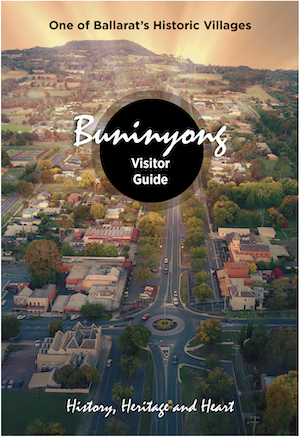- Details
Historic Places
The Wathaurrung people gave Buninyong its name and its history has been written in several places.
The Keyeet balug clan of the Wada Wurrung (or Wathaurong) tribe first occupied the Mount Buninyong area and an aboriginal burial site was located in the 1860s. More recently, stone tools have been found but a full archaeological survey has not yet been conducted.
The first recorded ascent of its summit by European colonisers in 1837 led to the first squatting runs being taken up in the district in 1838, and then to the establishment of the township of Buninyong in 1841.
Mount Innes (formerly known as Hastie's Hill) and the nearby Hastie's Spring commemorate the work of Rev Thomas Hastie, the first Presbyterian minister in the region in 1847 who opened the first inland boarding school there soon after. Today, Hastie's Hill has several interesting examples of original drystone rock walls.
In the township itself, an early Burial Ground was established in the 1840s then replaced by the current cemetery in the 1850's.
In August 1851 the small village of Buninyong was transformed by the announcement of gold found by the local blacksmith, Thomas Hiscock. The site of this momentous discovery is marked today by a plaque in Hiscock's Gully Road. Buninyong became the early centre of the goldfields administration and embarked on an era of growth.
Buninyong's Botanic Gardens (pictured above) were laid out in the 1870's and the mature plantings with the rotunda built in 1901 to commemorate the reign of Queen Victoria, create a picturesque oasis today.
Lal Lal Falls and Blast Furnace
The Falls and Blast Furnace at Lal Lal are both of exceptional historic interest. The blast furnace represents the only attempt to smelt iron ore in Victoria and is believed to be only example in the Southern Hemisphere remaining from the nineteenth century. It has an ‘A’ classification from the National Trust. See Lal Lal Blast Furnace for more information.
The Lal Lal Falls, situated within the traditional country of the Wathawurrung people, is one of Victoria's most significant Indigenous cultural sites, as it is one of several recorded living sites of Bundjil- the Kulin peoples' creator spirit. Lal Lal Falls (later) ... became a tourism attraction for non-Indigenous Australians for its natural and cultural values.(Clark, Ian D., The Ebb and Flow of Tourism at Lal Lal Falls, Victoria: A Tourism History of a Sacred Aboriginal Site, Australian Aboriginal Studies)


